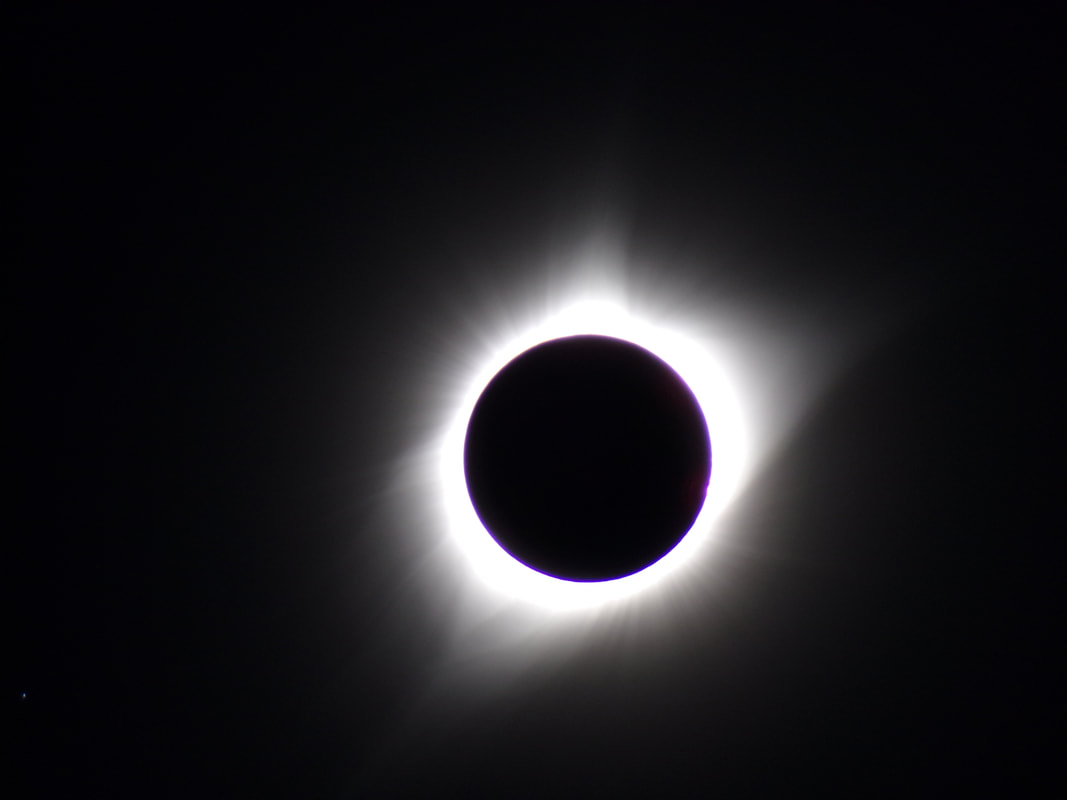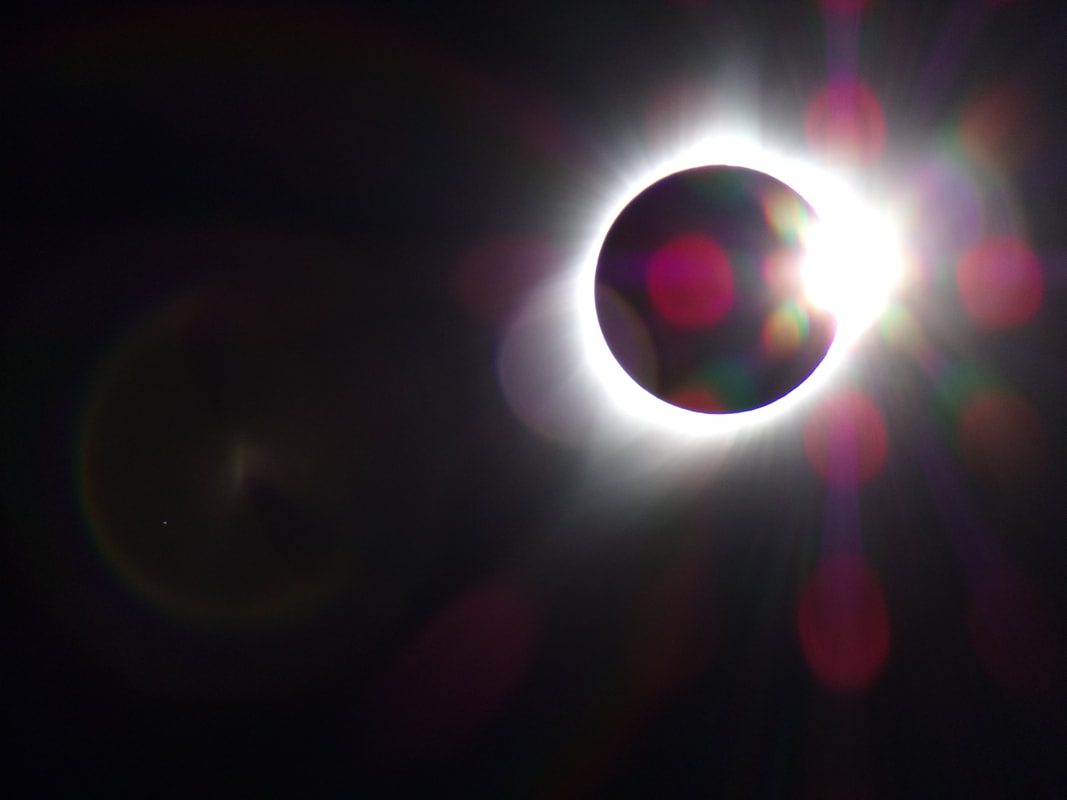#88---See at total Solar Eclipse
(excerpt of my travel blog titled "2017--Long Colorado Weekend", August 21, 2017)
10:23 arrived and a few minutes later I donned my glasses and got my first look at the son. The moon had taken a tiny bite out of the upper right section. I had made a trip back to car to get my tripod. I had made up my mind not to try to get pictures of the various phases, but I had hoped that if I set the camera to its night-time setting, I could the total eclipse, and maybe the diamond ring, which happens right before. So I set that up and kept the lens covered to prevent possible damage.
Through the next hour and 15 minutes I would intermittently look up to monitor progress. Margo made us sandwiches around 11 AM and we had an early lunch. The sun was about half gone, but the loss of light was barely noticeable. It kind of felt like a large cloud was just about to pass over; that period when the light decreases just a bit, before the full part of the cloud in engaged.
When it got to about 11:35, or 11:40, the loss of light was noticeable. The sun was about 90% gone, and I was thinking this is what home was going to look like when totality hit. It was going to be just dark enough to make people think that they were missing something, or wondering what the real fuss was. They would be thinking, “So big deal, it got a little dark”
The last minute of the eclipse was marked by someone behind us giving the small group of a people a play be play, with comments like “Not yet, not yet” or “almost, almost”. I think it for the benefit of the kids, so they would know when to take off their glasses and few the totality in its unfiltered glory.
I don’t think it was necessary, but it did add a sense of drama. As the sun winked out, I started pressing the shutter button on my camera, not really caring what it was seeing. I wanted to make sure that I saw it, and not as concerned about documenting the event.
The street lights came on moments after the sun was blotted out. When you looked around there was a 360 degree sunset effect as the clouds on all visible horizons were a reddish tin. Some shouted that a nighthawk was flying by. I looked up in time to see the silhouette of a large bird. I thought it more resembled a gull, but I only got a quick glance.
My attention turned to my camera and it looked like my image was pretty small, so I zoomed in. I was centered close enough that the result was dramatic. I instantly had a much larger view, and I was able to take about six very good pictures of totality, with a corona around them. Then once the moon had had its way with the sun, and the latter began to peek out, I got a couple more pictures, and got a couple of decent shots of the diamond ring. I was very happy.
At totality, it did not get completely dark. It was like mid dusk, there was light enough to see, but not light enough to say play catch or Frisbee. But, you be able to walk around without walking into a pole. Venus came out and you could see it, and maybe one or two other stars. I heard someone say that one of those was Jupiter, but my astronomy knowledge was limited, as was my attention, which was focus on the two major celestial bodies of the day.
As soon as totality was achieved the park cheered and applauded the performance. Then it was mostly silent as people observed and then started announcing their discoveries or commenting on the majesty of the event. It lasted for about two minutes, which seemed both long and short at the same time. It gave you enough to truly appreciate the uniqueness of the event, but short enough to definitely leave you wanting more.
Then it was over, and day time seemed to return much quicker that it had left us.
Through the next hour and 15 minutes I would intermittently look up to monitor progress. Margo made us sandwiches around 11 AM and we had an early lunch. The sun was about half gone, but the loss of light was barely noticeable. It kind of felt like a large cloud was just about to pass over; that period when the light decreases just a bit, before the full part of the cloud in engaged.
When it got to about 11:35, or 11:40, the loss of light was noticeable. The sun was about 90% gone, and I was thinking this is what home was going to look like when totality hit. It was going to be just dark enough to make people think that they were missing something, or wondering what the real fuss was. They would be thinking, “So big deal, it got a little dark”
The last minute of the eclipse was marked by someone behind us giving the small group of a people a play be play, with comments like “Not yet, not yet” or “almost, almost”. I think it for the benefit of the kids, so they would know when to take off their glasses and few the totality in its unfiltered glory.
I don’t think it was necessary, but it did add a sense of drama. As the sun winked out, I started pressing the shutter button on my camera, not really caring what it was seeing. I wanted to make sure that I saw it, and not as concerned about documenting the event.
The street lights came on moments after the sun was blotted out. When you looked around there was a 360 degree sunset effect as the clouds on all visible horizons were a reddish tin. Some shouted that a nighthawk was flying by. I looked up in time to see the silhouette of a large bird. I thought it more resembled a gull, but I only got a quick glance.
My attention turned to my camera and it looked like my image was pretty small, so I zoomed in. I was centered close enough that the result was dramatic. I instantly had a much larger view, and I was able to take about six very good pictures of totality, with a corona around them. Then once the moon had had its way with the sun, and the latter began to peek out, I got a couple more pictures, and got a couple of decent shots of the diamond ring. I was very happy.
At totality, it did not get completely dark. It was like mid dusk, there was light enough to see, but not light enough to say play catch or Frisbee. But, you be able to walk around without walking into a pole. Venus came out and you could see it, and maybe one or two other stars. I heard someone say that one of those was Jupiter, but my astronomy knowledge was limited, as was my attention, which was focus on the two major celestial bodies of the day.
As soon as totality was achieved the park cheered and applauded the performance. Then it was mostly silent as people observed and then started announcing their discoveries or commenting on the majesty of the event. It lasted for about two minutes, which seemed both long and short at the same time. It gave you enough to truly appreciate the uniqueness of the event, but short enough to definitely leave you wanting more.
Then it was over, and day time seemed to return much quicker that it had left us.

